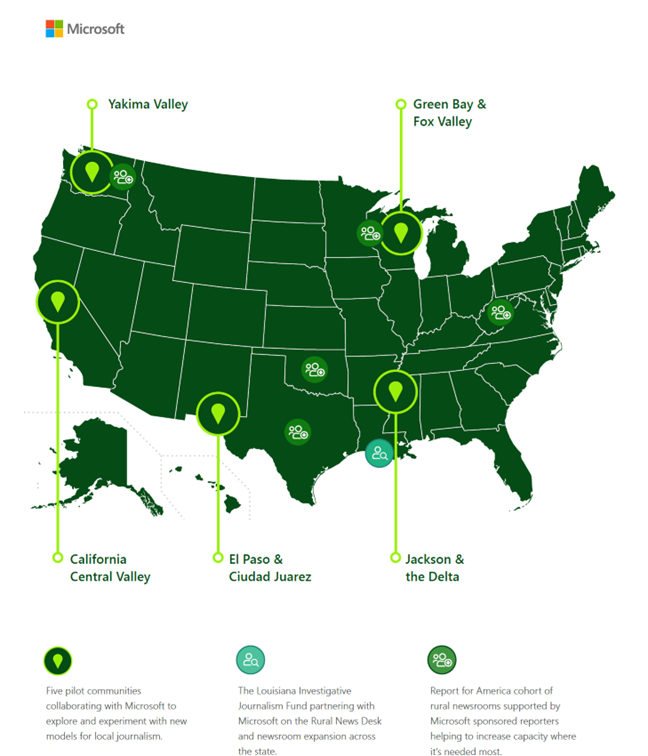Nearly three years ago, Microsoft launched a journalism initiative to explore ways in which we could help address the growing crisis facing independent local news organizations and preserve and protect journalism. The crisis is well documented, there are now over 2,500 communities that have lost their local newspapers, with many more relying on “ghost newspapers” that provide little or no local coverage. The number of newspaper newsroom staff per 100,000 people living in the U.S. has declined 62%, and the number of reporters per $100 million in local government spending has fallen 67%.
 As part of our work to address this crisis and turn the tide in favor of more successful and sustainable local newsrooms, today we are announcing the release of a comprehensive guidebook focused on giving independent local news organizations the strategies, tools, and support they need to strengthen their sustainability.
As part of our work to address this crisis and turn the tide in favor of more successful and sustainable local newsrooms, today we are announcing the release of a comprehensive guidebook focused on giving independent local news organizations the strategies, tools, and support they need to strengthen their sustainability.
Inspired by the classic subway maps and travel books that efficiently and effectively help people navigate complex systems. The guidebook provides a framework for understanding choices available to journalists, newsrooms, civic institutions, and community stakeholders. The insights and learnings highlighted in the guidebook came from direct engagement with five pilot communities around the U.S., and their local community foundations that helped develop and support new local journalism collaborations.
These communities and new local news collaborations include:
- El Paso and Ciudad Juarez
The Puente News Collaborative - Green Bay and Fox Valley
The Northeast Wisconsin (NEW) News Lab - Jackson and the Delta
Mississippi Spotlight - California Central Valley
The Central Valley News Collaborative and the Central Valley Journalism Collaborative - Yakima Valley
The Yakima Valley News Collaborative
These pilots provided an opportunity for us and the participants to gain insight, create greater impact, experiment with new practices, and unlock local, regional, and national funding for shared sustainability. ‘In some communities, they also provided support for the development of larger superstructures, where newsrooms, community foundations, and funders come together to create innovative funding and organizational models to sustainably support local news across a wider geographic region. These new superstructures are essential to rebuilding a robust local news ecosystem that can effectively cover underrepresented communities.
 An additional key to rebuilding local news capacity lies in the ability to adapt and innovate. Akin to introducing a more efficient subway system to a sprawling city, we needed to employ a mix of approaches – or pathways – to help reinvigorate the news industry. These insights have led us to focus on six critical tracks:
An additional key to rebuilding local news capacity lies in the ability to adapt and innovate. Akin to introducing a more efficient subway system to a sprawling city, we needed to employ a mix of approaches – or pathways – to help reinvigorate the news industry. These insights have led us to focus on six critical tracks:
- Leveraging existing resources
- Centering on collaboration
- Integrating technology
- Designing for sustainability
- Embracing market transformation
- Harnessing educational opportunities
The guidebook also highlights our innovative partnerships with news organizations and new funding approaches to rebuild capacity in rural and underserved communities. For example, in Louisiana, the Times-Picayune, the Advocate, and the Acadiana Advocate created the Louisiana Investigative Journalism Fund and launched a unique statewide Rural News Desk. This successfully expanded into Shreveport-Bossier, which was on the verge of becoming a news desert. Additionally, Report for America, a national service program, developed a specific cohort of rural newsrooms in need of additional reporting capacity to cover stories unique to rural communities.
We are incredibly grateful to all of the pilot newsroom partners we have worked with over the past several years to explore these newsroom solutions. Microsoft is committed to advancing equitable and fair societal systems that support people’s fundamental rights including protecting journalism as a critical component of any democratic process.
Turning the lights back on – a collaborative journey
Hear the reporters, publishers, community leaders and others describe the importance of local news to their communities and the impact of their collaborative approach.
In addition, Microsoft recently launched our Journalism Hub to connect newsrooms and journalists with the kinds of resources and technology they need to help implement the guidebook.
We know the journey toward remaking and re-energizing local journalism is far from over. The challenges are varied and complex, with new issues and opportunities appearing frequently along the way. We’re committed to staying the course, to continue mapping out this system, and to keep working toward a future where journalists have the tools, protections and resources they need to do their critically important work.
While the issues facing journalism are too important for any one organization to try and solve in isolation, Microsoft is determined to play its part. That’s why we announced our partnership with USAID and Internews earlier this year to support the development of a Media Viability Accelerator. We encourage other private-sector companies, funders, newsrooms and solution providers to play their part as well in this collaborative effort to rejuvenate journalism and strengthen democracies worldwide. As we continue this journey, we’ll continue to share our insights, learnings, and progress.

